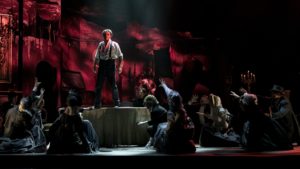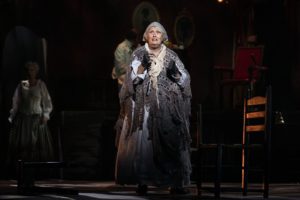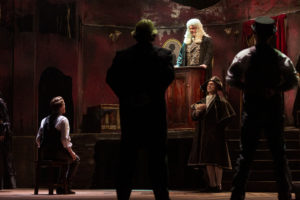Music, Lyrics by Stephen Sondheim. Book by Hugh Wheeler. Life Like Company. Directed by Theresa Borg. Darling Harbour Theatre, ICC, Sydney, 13-16 June, 2019 and Her Majesty’s Theatre, Melbourne, 20 – 23, June.
Reviewed : June 13, 2019

Forty years ago Sweeney Todd scored eight Tony awards in New York and the Olivier award for Best New Musical in London. It’s been revived twice on Broadway, four times in London, been produced in other places around the world including productions by The State Opera of South Australia, MTC and Opera Australia. Other productions abound. What is it that makes this macabre musical so popular?
Is it the grisly – or should that be gristly – story of a barber who slits the throats of his victims, minces them and serves them up in his landlady’s pie shop? Could be … after all the story’s been doing the rounds in Europe since the fourteenth century. More likely it’s the fact that Stephen Sondheim retold the gruesome tale with his inimitable rhythms and counter-rhythms – and lyrics that complement the counter-point of the score, some of them with cockney-style humour reminiscent of Gilbert and Sullivan.
In fact, Sweeney Todd is more opera than musical. The themes are certainly operatic – stolen love, revenge, murder – and only twenty percent of the words are spoken. Sondheim himself apparently called it a ‘black operetta’.

This fortieth anniversary tribute, directed by Theresa Borg, accentuates the horror, the humour and the music. Though a ‘concert version’, the set, designed by Charlotte Lane, takes the action into the seedy atmosphere of 19th century London. The lower level of the set transforms from pie shop to street. The only props are a table and a flickering ‘furnace’. Stairs lead to Todd’s barber shop, where once again minimal props create the scene: a chair, a trunk and the door through which Todd’s victims disappear. The dark, earthy colours of the peeling walls emphasise the stark red of the deadly barber’s chair.
Musical director Vanessa Scammell conducts twenty-two accomplished musicians who are seated on a cunningly designed extension of the stage that winds through the orchestra to two exits. Thus, the actors and musicians are as closely connected as the lyrics and the music.
Costume designer, Kim Bishop, has used only black, white and multiple shades of grey to create the costumes. Under moody lighting (Tom Willis), the performers appear in a sombre haze of cloudy grey that heightens the ‘under-worldly’ theme of the set – their characters as clear and strong as their amplified voices.
Anthony Warlow is a formidable Sweeney Todd, his voice resonating with the anger and anguish of the barber’s pain – a hurt that Gina Riley offsets with Mrs Lovett’s spicy humour and sharp wit. Riley’s skilled comic timing sits well with the lyrics and the tempo of Lovett’s songs. These two accomplished actors add depth and dimension to the characters as they sing.
Debra Byrne hides in folds of fabric as the Beggar woman, crying for ‘alms’ one moment, vicariously offering herself the next. Byrne is obviously having fun with this role, finding the pathos and humour of Sondheim’s words and Borg’s direction.

Tod Strike stepped in adeptly on opening night to replace Michael Falzon as Adolfo Pirelli, the barber who becomes Todd’s first victim. Daniel Sumegi brings his vast operatic experience to the role of Judge Turpin, with Anton Berezin as his partner-in-crime, Beadle Bamford. The ‘youngsters’ in the story – Jonathan Hickey as Tobias Ragg, Owen McCredie as Anthony Hope and Genevieve Kingsfored as Johanna – bring light and hope to the tale and the tone of the music. The chorus – some of whom also act as stage crew – move in song from passers-by, to pie shop customers, to ghostly apparitions.
The distance from the stage in this large venue may have disappointed some in the audience. For me it added to the gloom and grisliness of the story, and the acoustics highlighted the fact that this is indeed a ‘concert version’, where music and the voices are supposed to shine. Fortunately, Theresa Borg and her creative team also crafted the atmosphere and vibe that Sondheim and Hugh Wheeler incorporated into their ‘black operetta’.